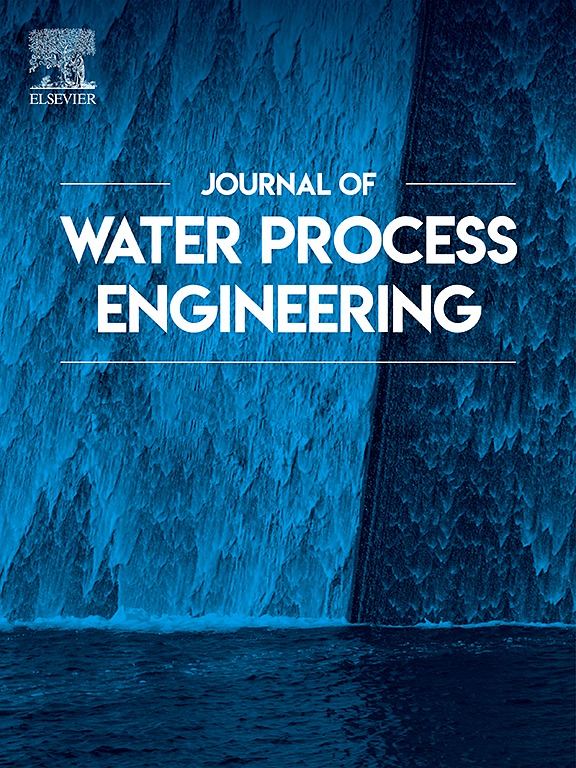MIL-88-A(Fe)/PVDF coated stainless steel mesh using the drop casting method: A Superior photocatalyst for Cr(VI) reduction in aqueous solutions
IF 6.3
2区 工程技术
Q1 ENGINEERING, CHEMICAL
引用次数: 0
Abstract
Chromium (VI) contamination in water sources poses severe environmental and health risks due to its high toxicity and carcinogenic properties, necessitating the development of efficient treatment methods. This study presents a novel technique for the photocatalytic reduction of Cr(VI) using iron-based MOF combined with a polymer coated on a stainless steel mesh using the drop-casting method. The photocatalyst was created by coating MIL-88-A(Fe) and PVDF as polymeric binders on the mesh surface, displaying strong adhesion and suitable exposure to the target pollutant, maintaining 85 % efficiency after 5 recovery cycles, indicating good stability and reusability. The photocatalytic performance of the modified stainless steel mesh was evaluated under photocatalytic and sonophotocatalytic conditions. The results show that a significant increase in Cr(VI) reduction is achieved when ultrasonic irradiation is applied simultaneously with light irradiation, attributed to the synergistic effects of ultrasound and the photocatalyst. Additionally, under optimal conditions, including pH 2, 60 min, 25 mg hole scavenger, 30 ppm initial Cr(VI) concentration, and 75 mg MOF loading, the photocatalytic system achieved 96 % Cr(VI) reduction. The prepared photocatalysts were characterized using X-ray diffraction, fourier transform infrared, UV–Visible, scanning electron microscopy, and energy-dispersive X-ray analysis. This study confirmed the superior efficiency of the sonophotocatalytic method compared to the photocatalytic method for MIL-88-A(Fe). It also shows the potential of integrating MOFs with polymer binders on stainless steel mesh for efficient and sustainable water treatment solutions.

求助全文
约1分钟内获得全文
求助全文
来源期刊

Journal of water process engineering
Biochemistry, Genetics and Molecular Biology-Biotechnology
CiteScore
10.70
自引率
8.60%
发文量
846
审稿时长
24 days
期刊介绍:
The Journal of Water Process Engineering aims to publish refereed, high-quality research papers with significant novelty and impact in all areas of the engineering of water and wastewater processing . Papers on advanced and novel treatment processes and technologies are particularly welcome. The Journal considers papers in areas such as nanotechnology and biotechnology applications in water, novel oxidation and separation processes, membrane processes (except those for desalination) , catalytic processes for the removal of water contaminants, sustainable processes, water reuse and recycling, water use and wastewater minimization, integrated/hybrid technology, process modeling of water treatment and novel treatment processes. Submissions on the subject of adsorbents, including standard measurements of adsorption kinetics and equilibrium will only be considered if there is a genuine case for novelty and contribution, for example highly novel, sustainable adsorbents and their use: papers on activated carbon-type materials derived from natural matter, or surfactant-modified clays and related minerals, would not fulfil this criterion. The Journal particularly welcomes contributions involving environmentally, economically and socially sustainable technology for water treatment, including those which are energy-efficient, with minimal or no chemical consumption, and capable of water recycling and reuse that minimizes the direct disposal of wastewater to the aquatic environment. Papers that describe novel ideas for solving issues related to water quality and availability are also welcome, as are those that show the transfer of techniques from other disciplines. The Journal will consider papers dealing with processes for various water matrices including drinking water (except desalination), domestic, urban and industrial wastewaters, in addition to their residues. It is expected that the journal will be of particular relevance to chemical and process engineers working in the field. The Journal welcomes Full Text papers, Short Communications, State-of-the-Art Reviews and Letters to Editors and Case Studies
 求助内容:
求助内容: 应助结果提醒方式:
应助结果提醒方式:


